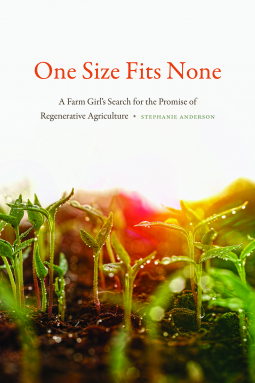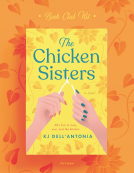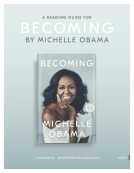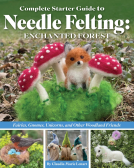
One Size Fits None
A Farm Girl's Search for the Promise of Regenerative Agriculture
by Stephanie Anderson
This title was previously available on NetGalley and is now archived.
Send NetGalley books directly to your Kindle or Kindle app
1
To read on a Kindle or Kindle app, please add kindle@netgalley.com as an approved email address to receive files in your Amazon account. Click here for step-by-step instructions.
2
Also find your Kindle email address within your Amazon account, and enter it here.
Pub Date Jan 01 2019 | Archive Date Jan 31 2019
Talking about this book? Use #OneSizeFitsNone #NetGalley. More hashtag tips!
Description
In One Size Fits None Anderson follows diverse farmers across the United States: a South Dakota bison rancher who provides an alternative to the industrial feedlot; an organic vegetable farmer in Florida who harvests microgreens; a New Mexico super-small farmer who revitalizes communities; and a North Dakota midsize farmer who combines livestock and grain farming to convert expensive farmland back to native prairie. The use of these nontraditional agricultural techniques show how varied operations can give back to the earth rather than degrade it. This book will resonate with anyone concerned about the future of food in America, providing guidance for creating a better, regenerative agricultural future.
Advance Praise
“A brave and clear-eyed book by a farmer’s daughter about the problems in our agriculture and the factors that keep farmers from making it better. Stephanie Anderson . . . points the way toward an agriculture that regenerates our soil, our land, and our hopes.”—Kristin Ohlson, author of The Soil Will Save Us
“Stephanie Anderson deftly counterpoints profiles of innovative farmers with affectionate yet honest reflections on her family’s farm—and the compromises the industrial model demands. Anderson is a strong, new voice for an agriculture that works for public health, for nature, and for farmers.”—Judith D. Schwartz, author of Cows Save the Planet and Water in Plain Sight
“One Size Fits None should be required reading for anyone who yearns for a clear-headed and informed account of our dysfunctional corporate food system, which also examines hopeful models for reform.”—Andrew Furman, author of Bitten: My Unexpected Love Affair with Florida and Goldens Are Here
Available Editions
| EDITION | Other Format |
| ISBN | 9781496205056 |
| PRICE | $21.95 (USD) |
| PAGES | 312 |
Links
Featured Reviews
 Divya V, Reviewer
Divya V, Reviewer
I picked this book as I was curious about regenerative agriculture and more specifically, whether it was viable for commercial production and this book delivered. The author Stephanie is deeply invested in farming and you can see clearly the evolution of her thinking on "conventional" agricultural practices over time and exposure to agrobusiness ventures. As a layman, this book is packed full of facts, but written in an articulate, readable style, and I ended up reading it cover to cover over a couple of days. Would definitely recommend it to anyone who wants to know more about why we need to go beyond sustainability to regenerative land management.
 Jim R, Reviewer
Jim R, Reviewer
I requested and was granted a review copy of this from the publisher The University of Nebraska Press through NetGalley..
I fear that Ms. Anderson's book will be lost and essentially unread. Yes, it was only published in January 2019, but as of this writing, I found only one other review on Goodreads and three non-review ratings; the same review is cross-posted on Amazon (and it is the only rating there); even NetGalley has only one other review; and a handful of blog posts. More's the pity because there is an important, even vital message here. Ms. Anderson looked at "conventional" agriculture, holistic regenerative agriculture, organic regenerative, and lastly (in the book) diversified regenerative agriculture, arranging the four investigations into those four parts. She grew up on a conventional ranch in South Dakota, disagrees now with her father on pretty much everything agricultural (still "pals" but they don't talk about it), knows that "most conventional farmers and ranchers are good people trapped in a bad system", admits in her first journalist job out of college for a Sioux Falls, South Dakota farm-and-ranch newspaper that she was "twenty-one and naive, ..., born and bred to believe American agriculture was sacred." That's an all-too-common tragedy...thinking that American anything is sacred...but she went on a quest to find out if her family's ranch - and all American agriculture by extension - had a place in a better agriculture future.
In Conventional, Ms. Anderson looks at how we got where we are; the struggles of the small farmers/ranchers; the industrialization, gigantism, and specialization of the business; the effects of chemicals and the methods on the products and land; the devastating effects of conventional agriculture on soils and the environment; the unfortunate need for subsidies for the business to survive. It was all about "conquering" the land, a common theme for Euro-westerners. Conventional farming actually loses jobs...as farming and ranching become more industrialized, more chemical, more automated and remote, fewer eyes and hands are needed. And despite what some vocal minorities would have you believe, the lion's share of the workers who do remain for the non-mechanical harvesting and handling are not corn-fed farmers but largely Hispanic because according to Ryan Roth, a Florida farmer, "All of these jobs Americans don't want to do." Further hurting the entire system is the fact that conventional farmers cannot set their own prices for produce and livestock. Still, there are "good people" trapped in that system who are trying to be better stewards.
In Holistic Regenerative, Anderson looks at methods of management that are operational and holistic because they take into account the whole ecosystem - "soil, plants, insects, grazers, wildlife, people" - in order to stop and hopefully reverse desertification. She also examines the standard delivery process of CAFO - concentrated animal feeding operations - confining animals for a period of time, jamming grains to "fatten" them up before slaughter. If "grass fed" has taught anything, it's that the grain-fed crap we get in the meat market sections is horrible (my words, more or less...but she covers it all...and don't be fooled into thinking "organic" is not CAFO'd). The part on holistic regenerative gives hope, but there are still too many big business, capitalistic drivers opposing intelligent farming/ranching and conventional farming. Worse, too many industrial lobbyists have helped thirteen states as of the publication to adopt food disparagement laws that make criticizing food products illegal - and if that is not a huge WTF? I don't know what is. So a step in the right direction is to consider the whole and not the parts, or the end.
Organic Regenerative takes the holistic lessons to the next level, but it is not without problems, and consumers should be wary...Phil Jerde, of Great Plains Buffalo says that the organic rules were watered down significantly; organic rules have significant loopholes: parasiticides are allowed in breeding stock if preventative measures fail. Ms. Anderson correctly notes the abuse of the environment is a consequence of the Judeo-Christian "dominion narrative". "Human authority over the natural world sanctioned by God - a license for destruction." It's a common Western thought. Organic is more than using natural means to control insect and herbivorous pests - it generally gives the farmer/rancher a small measure of control over the market, sometimes selling directly to consumers and setting their own prices, while providing a fresher and tastier product. Even though organic has gained traction, people know that organic foods taste better and are more nutritious, there is still the underlying social acceptance of "conventional" agriculture. The problem there is that "conventional sounds right, but in reality, it isn't...it is a recent (150+ years) perversion of true conventional agriculture that allowed for natural sustainability of the environment. Rodale Institute has conducted a continuing study since 1981 on conventional versus organic to look at agribusiness claims that industrialization was the only way to produce enough food for the future. The side-by-side evaluation has shown and continues to show that organic consistently has comparable or higher yields than conventional, so that argument fails. The advantage of Rodale's study is its long-term nature...single studies are snapshots. Rodale's 2011 summary states <blockquote>After thirty years of a rigorous side-by-side comparison, the Rodale Institute confidently concludes organic methods are improving the quality of our food, improving the health of our soils and water, and improving our nation's rural areas. Organic agriculture is creating more jobs, providing a livable income for farmers, and restoring America's confidence in our farming community and food system.</blockquote>
Ms. Anderson's last part considers a Diversified Regenerative that disrupts the system for what practitioners believe is a necessary and positive effect. Changing products raised and delivered is not what a ...conventional ... consumer wants; it's not convenient, and people are not usually open to new things. But it has tremendous effects on regenerating soils. It's not rotating crops, which just continues to eat the soils, just more slowly. Increased natural soil ventilation by earthworms is possible by eliminating pesticides and synthetic nitrogen sources. Laying down ground cover crops for wildlife to eat, naturally till with hooves, fertilize (natural nitrogen), actually helps food crops to yield more thanks to increased organic matter levels.
I've done a poor job shotgunning my notes and summaries. There is real value in this as I said in the beginning, I fear it will be largely unseen. Even those who are aware feel it is too late. The "midsize farms are too big to retail products at most farmers' markets, but too small to compete in the highly consolidated commodity markets." The well-chosen title is important to come back to: one size certainly does not fit all, and the chosen one size of "conventional truly fits none.
One Size Fits None is an exposition on agriculture and specifically what we as a society can do to change our systems and to what degree we can reverse the damage we've wrought to our biome. Author Stephanie Anderson grew up on a traditional midwest farm and began to question the agricultural production models during and after her college education. She makes a compelling case for the idea that not only is a sustainable paradigm necessary, we absolutely must also make changes to repair and compensate for previous damage by farming regeneratively.
Released 1st January 2019 by the University of Nebraska press, it's 312 pages and available in paperback and ebook formats.
The book is split into four main sections. The first section describes and provides insights into the traditional large-scale agricultural model. Farms are 'factories' producing generally one or two specialized crops at maximum speed and volume. The farms are run on such a huge scale that mechanized production is a necessity and sowing, weeding, maintenance and harvesting rely on large industrial machinery. Soil fertility and crop production are dependent on artificially applied chemical fertilizers which leads to decreased soil function which in turn increases reliance on more inorganic fertilizers. The author makes a compelling argument for the unsustainability of the treadmill that is the current system of agriculture. The question, then, is how to make a change.
The second section deals with a shift in paradigm to a regenerative holistic system. The model she discusses in the book is based on buffalo and other large herbivores grazing grassland in the midwest USA. The studies she cites showed an increase of soil health and plant diversity when organic methods are utilized which allows for a more complete cycle, since the insects and birds aren't killed off by using pesticides. I enjoyed reading about the farmer documenting the insect activity of the poop left by the buffalo (dung beetles process and drag the nutrients from the poo into the soil where it continues the cycle).
The third section of the book covers plant based organic methods of food production. I enjoyed the way the author writes about the farmers she profiles in the book. There is an emphasis on their methods, true, but she manages to emphasize their creativity, problem solving, and humanity at the same time.
The fourth section of the book brings the second and third together with a balanced smallholding model which incorporates both animals and plants in a cohesive whole. There is a common catchphrase in agriculture today 'Get big or get out'! This book makes a very compelling case why that is absolutely the wrong model if we want to repair the catastrophic damage we've done to the planet we all call home.
Even for people who aren't directly interested in engaging directly in food production, educating ourselves about food security and diversity is critically important now, before it's too late.
This book provides a wealth of further reading in the bibliography.
I remember reading Silent Spring decades ago and being absolutely electrified. This book gives me the same feeling. This is a very important book.
Five stars
Readers who liked this book also liked:
Silvia Moreno-Garcia
Historical Fiction, Literary Fiction, Sci Fi & Fantasy


















